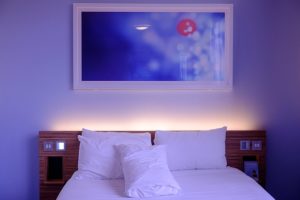 As someone going through the process of decorating or renovating your [city] home, you’ve probably spent hours looking at photos of beautiful homes and rooms on website and magazines. Perhaps you’ve picked a few appealing interior designs, and want to get the same effect in your home.
As someone going through the process of decorating or renovating your [city] home, you’ve probably spent hours looking at photos of beautiful homes and rooms on website and magazines. Perhaps you’ve picked a few appealing interior designs, and want to get the same effect in your home.
What many homeowners don’t know is that a huge part of what makes great interiors great is lighting. While much is said about picking the right furniture, and matching pieces with your wall colors, lighting is largely underappreciated.
How Does Color Change a Room?
Let’s say that the walls in your living room are painted in a shade of beige or white. Even though all the walls look the same, the placement of furniture creates angles and shadows, depending on how they’re positioned in relation to your lighting. The color of light has an even more distinct effect on the room. As the day progresses, the color of natural sunlight shifts, making the room appear welcoming, airy, or cozy among others.
Below are a few ideas to use lighting color effectively in your home.
- Evoke a feeling of warmth
If you want to create an atmosphere of warmth and softness, look for LED light bulbs with a color temperature of around 2700K (Kelvin), which is equal to a soft yellow glow. These bulbs are great for bedrooms and living rooms, where the primary activities are rest and relaxation.
- Support Alertness with Brightness
If the primary activities in a room need full alertness, look for cooler bulbs with a color temperature of around 4000K. This will generate a light that appears closer to white than yellow, which is ideal for areas like the kitchen and garage/workshop. After all, you need to be fully alert when cooking and working with tools in these rooms.
- Get as Close to Natural Daylight
Natural sunlight at around noon has a color temperature of about 5,000K to 6,000K. This is a very cool light, usually best for business environments with few windows, or homes in parts of the world where days are short and overcast—think cities and countries with harsh winters.
- Use Complementing Fixtures to Flatter the Color of Your Lighting
If you can’t buy light bulbs that generate a specific color that you like, you can always tweak your existing bulbs by using a fixture shade that changes the light. Glass or enclosed shades are an ideal solution to this problem. However, be advised that enclosed shades limit your bulb options; the lifespan of halogens and CFLs can be reduced due to build up of heat inside an enclosed shade.
- Mix and Match
There’s no reason to choose just one set of bulbs in a single color temperature, not when you can actually layer your lighting.
For example, in your living room, you can install cool white LEDs for your recessed lighting—this can be your base layer. You can then use warmer light bulbs for your floor and desk lamps, spotlights, and accent lighting—this will be your second layer.
You can switch to your first layer of lights when you’re entertaining guests or have a party. On the other hand, your second layer of warm lighting can be the default option on regular days when you’re just lounging around at home.
Just be sure to do your homework so you understand how certain light colors affect the appearance of your interior spaces. When all else fails, just consult the services of an interior designer, who will know the delicate interplay between light, space, and interior pieces.

![Transform Your Master Bedroom into a Sanctuary With These 7 Lighting Ideas [city]](https://eepros.com/wp-content/uploads/2018/12/wall-416062_640-300x169.jpg)
![3 Tips for Maintaining Your LED Lighting and Improving Its Lifespan [city]](https://8blocks.s3-us-west-1.amazonaws.com/eepros/2020/social.jpg)
![How to Choose the Right Lumen Output for Your [city] Business [city]](https://8blocks.s3.amazonaws.com/eepros/blog-images/choosing-led-lumens.jpg)
![LED Lighting Plan for Commercial Food Processing [city]](https://8blocks.s3.amazonaws.com/eepros/blog-images/led-commercial-food-processing.jpg)